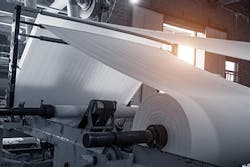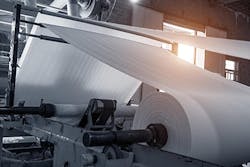Study Spotlights Pulp and Paper Processes
According to Eurostat, the statistics body of the European Union (EU), total annual industrial energy consumption in the bloc is 274,759 ktoe (kilotons of oil equivalent). The chemical and petrochemicals industry tops the list (52,611 ktoe), with iron and steel second (51,086 ktoe), non-metallic minerals third (33,997 ktoe) and the pulp and paper industry fourth (31,659 ktoe).
[pullquote]
The European Commission’s Joint Research Center (JRC) completed a new study into the pulp and paper industry, showing that by implementing best available technologies (BATs) and practices, by 2050 that sector could reduce energy consumption by 14% and greenhouse gas emissions by 62% compared to 2015 levels.
For the energy-intensive chemical pulping process, several technologies identified could bring significant savings in production costs while generating additional revenue.
For example, high-temperature heat recovery boilers and continuous digesters offer the greatest opportunities for energy savings — about 6GJ/mt of paper each. This would be achieved at a “reasonably low investment cost” of €860 ($996)/mt of pulp/yr for the boiler and €2,190 ($2,535)/mt pulp/yr for continuous digesters.
BATs also could improve the energy performance of the cooking process. These include technologies such as modified continuous cooking, extended modified continuous cooking, isothermal cooking and low solids cooking. Savings here are estimated at 3.2 GJ/mt of pulp at an investment cost of €130 ($151)/mt of pulp.
The report also notes that the most effective energy-efficient technique for mechanical pulping is heat recovered as byproduct, especially in the thermomechanical process. This BAT combines high energy savings (about 3.5 GJ/mt of pulp) with a low investment cost (€780 ($903)/mt of pulp). Payback can be a few months, depending on capital cost.
Figure 1. Reducing consumption by Europe’s fourth biggest energy user could play a big role in the continent’s transition to a low-carbon economy. Source: European Commission Joint Research Centre.
Other BATs for mechanical pulping include high-efficiency grinding, enzymatic pre-treatment and improvements in chemi-thermo-mechanical pulping and thermo-pulping but, as the study notes, “These opportunities are associated with higher investment costs.”
Moisture is a costly issue in pulp and paper processing. The study says significant energy reduction here is possible with more efficient water-removal devices and new drying technologies such as boost drying and microwave drying.
Combined heat and power (CHP) systems also fall under the study’s spotlight. Although the sector is one of the highest adopters of CHP power in the EU (accounting for around 10% of total capacity in Europe), the availability and cost of natural gas and long-term system reliability are important determining factors in its uptake. While capital investment is high, payback in a large mill could only take about three years, the report states.
The JRC also considers a number of new technologies, including biorefineries and two emerging processes — black liquor gasification (BLG) and LignoBoost.
The report predicts biorefineries will bring significant technological, economic and social advantages to the industry because of their versatility: “Different biorefinery pathways, utilizing biomass as raw material, can be applied to the pulp and paper sector by integration of new technologies such as BLG, biomass gasification, lignin/hemicellulose production and processing/synthesis units, to provide a wide range of pulp, paper, energy, fuel and chemical products using biomass as feedstock. Possible feedstocks include wood extract, spent black liquor, forest biomass, agro-lignocellulosic products and sludge.”
For its part, BLG helps obtain energy more efficiently from the organic content in the black liquor through gasification, producing a combustible gas which after upgrading and conditioning results in a mixture of hydrogen and carbon monoxide known as syngas, while recovering the inorganic chemical. The BLG’s hot flue gases can generate steam in a boiler, resulting in high pressure steam for power generation in a steam turbine. “Alternatively, the syngas can be used as feedstock for production of biofuels such as dimethyl ether, Fisher-Tropsch (FT) fuel, methanol, etc., turning the paper mill into a ‘refinery’,” says the JRC.
Meanwhile, LignoBoost is an emerging technology that enables extraction of up to 25–50 % of the lignin from the kraft black liquor via precipitation at low pH using carbon dioxide and dewatering. The lignin then can serve in other profitable applications such as producing chemicals and materials including carbon fibers, activated carbon, phenols and other value-added products.
The study concludes that to make the most of these opportunities, the pulp and paper industry — and others — need EU policies that support research and innovation.
Seán Ottewell is Chemical Processing's Editor at Large. You can email him at [email protected].


